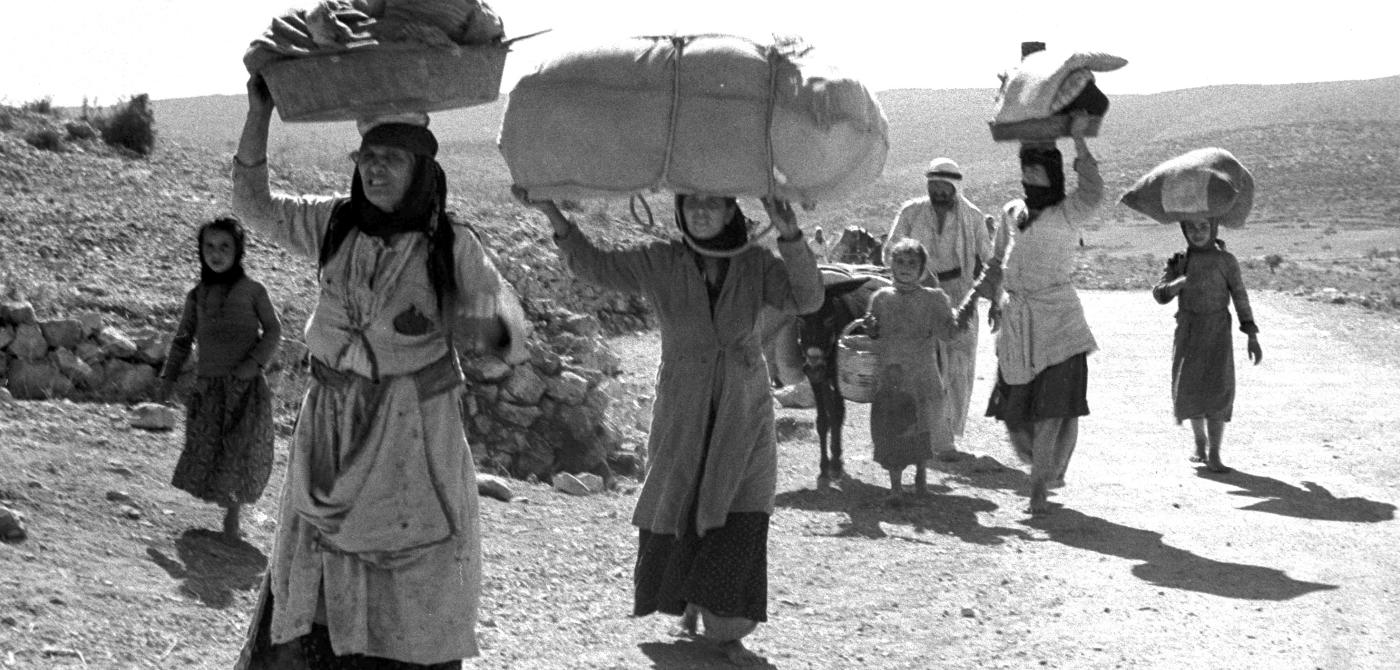
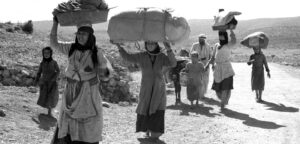
This post expands and updates an article previously published by The India Forum.
On 7 October 2023, Palestinian militant group Hamas launched a massive attack on Israeli territory, killing 1405 people including over 300 soldiers according to the Israeli state, although a month later the death toll miraculously came down to 1200. The Israeli state has responded by bombing the Gaza Strip, in which Hamas has its headquarters and over 2.3 million civilians have their homes, starving inhabitants of food, water, medicines and fuel. But why did this happen? And what can be done about it? On these questions, there is no agreement whatsoever.
Who is to blame?
In its editorial of 8 October 2023, the Israeli paper Haaretz was unequivocal in assigning responsibility for the death and destruction resulting from the Hamas ‘Operation Al-Aqsa Flood’:
The disaster that befell Israel on the holiday of Simchat Torah is the clear responsibility of one person: Benjamin Netanyahu. The prime minister… completely failed to identify the dangers he was consciously leading Israel into when establishing a government of annexation and dispossession, when appointing Bezalel Smotrich and Itamar Ben-Gvir to key positions, while embracing a foreign policy that openly ignored the existence and rights of Palestinians…
In the past, Netanyahu marketed himself as a cautious leader who eschewed wars and multiple casualties on Israel’s side. After his victory in the last election, he replaced this caution with the policy of a “fully-right government,” with overt steps taken to annex the West Bank, to carry out ethnic cleansing in parts of the Oslo-defined Area C, including the Hebron Hills and the Jordan Valley.
This also included a massive expansion of settlements and bolstering of the Jewish presence on Temple Mount, near the Al-Aqsa Mosque, as well as boasts of an impending peace deal with the Saudis in which the Palestinians would get nothing, with open talk of a “second Nakba” in his governing coalition. As expected, signs of an outbreak of hostilities began in the West Bank, where Palestinians started feeling the heavier hand of the Israeli occupier.i
Eighty-six per cent of Jewish Israelis shared the opinion that Netanyahu and his government were to blame for the attacks, according to a Dialog Center poll.ii The criticisms of some might have been limited to the epic failure of Israeli intelligence and security agencies, but some would have in addition been revolted by the domination of the government by right-wing extremists openly pursuing a policy of ethnic cleansing in the West Bank and East Jerusalem. Undoubtedly the fact that Netanyahu had for over ten years ‘turned Hamas from a terror organization with few resources into a semi-state body’ by allowing it to receive large-scale cash transfers and a broad array of goods including construction materials from Qatar contributed to Israeli fury with him. His goal was to divide the Palestinian Authority (PA) in the West Bank from Hamas in Gaza to prevent the establishment of a Palestinian state, leading to the conclusion that ‘The 2023 pogrom is a result of Netanyahu’s policy. It is not “a failure of the concept” – rather, this is the concept: Netanyahu and Hamas are political partners, and both sides have fulfilled their side of the bargain.’iii
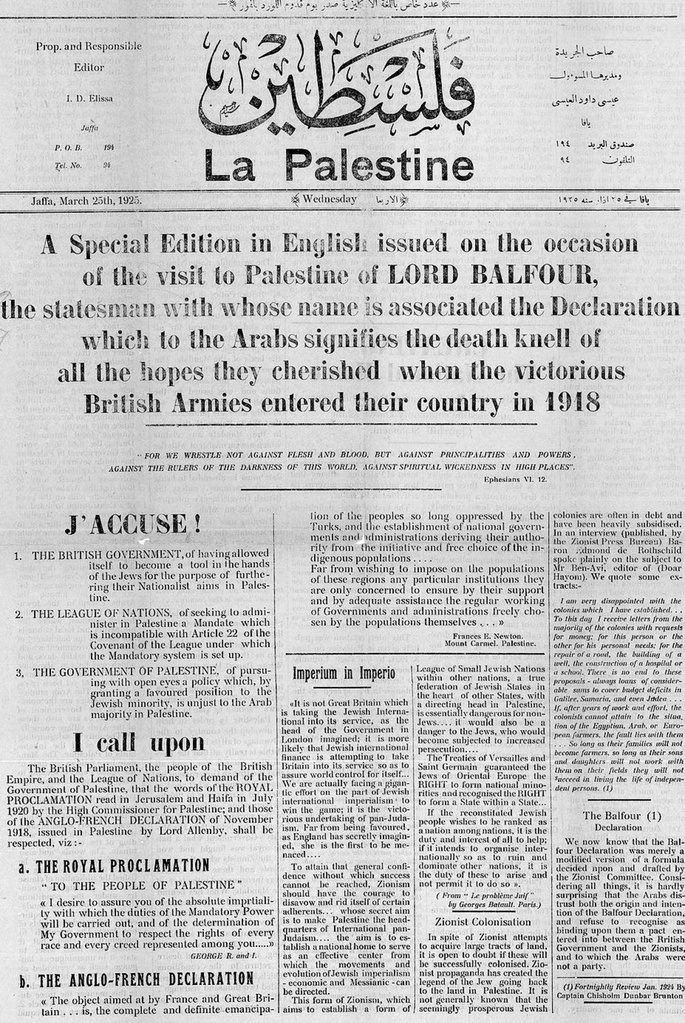
The front page of a special English edition of the Falastin newspaper featuring a four-page editorial addressed to Lord Balfour (25th March 1925) | Wikimedia
Gideon Levy, a well-known Israeli columnist who is on the Editorial Board of Haaretz, went further. He blamed
Israeli arrogance, the idea that we can do whatever we like, that we’ll never pay the price and be punished for it… We’ll arrest, kill, harass, dispossess and protect the settlers busy with their pogroms… We’ll fire at innocent people, take out people’s eyes and smash their faces, expel, confiscate, rob, grab people from their beds, carry out ethnic cleansing and of course continue with the unbelievable siege of the Gaza Strip, and everything will be all right…
On Saturday, they were already talking about wiping out entire neighbourhoods in Gaza, about occupying the Strip and punishing Gaza “as it has never been punished before”. But Israel hasn’t stopped punishing Gaza since 1948, not for a moment…
Prime Minister Benjamin Netanyahu bears very great responsibility for what happened… but it didn’t start with him and it won’t end after he goes.iv
Levy is referring to the ‘Nakba’ (Catastrophe), the ethnic cleansing of Palestine by Zionist militias in 1948. Most of these Palestinians ended up in refugee camps in other parts of Palestine or in neighbouring countries. But how did this happen? We need to go back further to find that out.
Historical background
In the late 19th century, Palestine was a thriving part of the declining Ottoman Empire with aspirations for independence. At the same time, a European Jewish nationalist movement – Zionism – was searching for a land to colonise. In 1920, after the Ottomans were defeated, the League of Nations, established by the victorious powers of World War I, created a system of ‘mandates’ to replace them in the countries they had colonised. The British received Palestine.
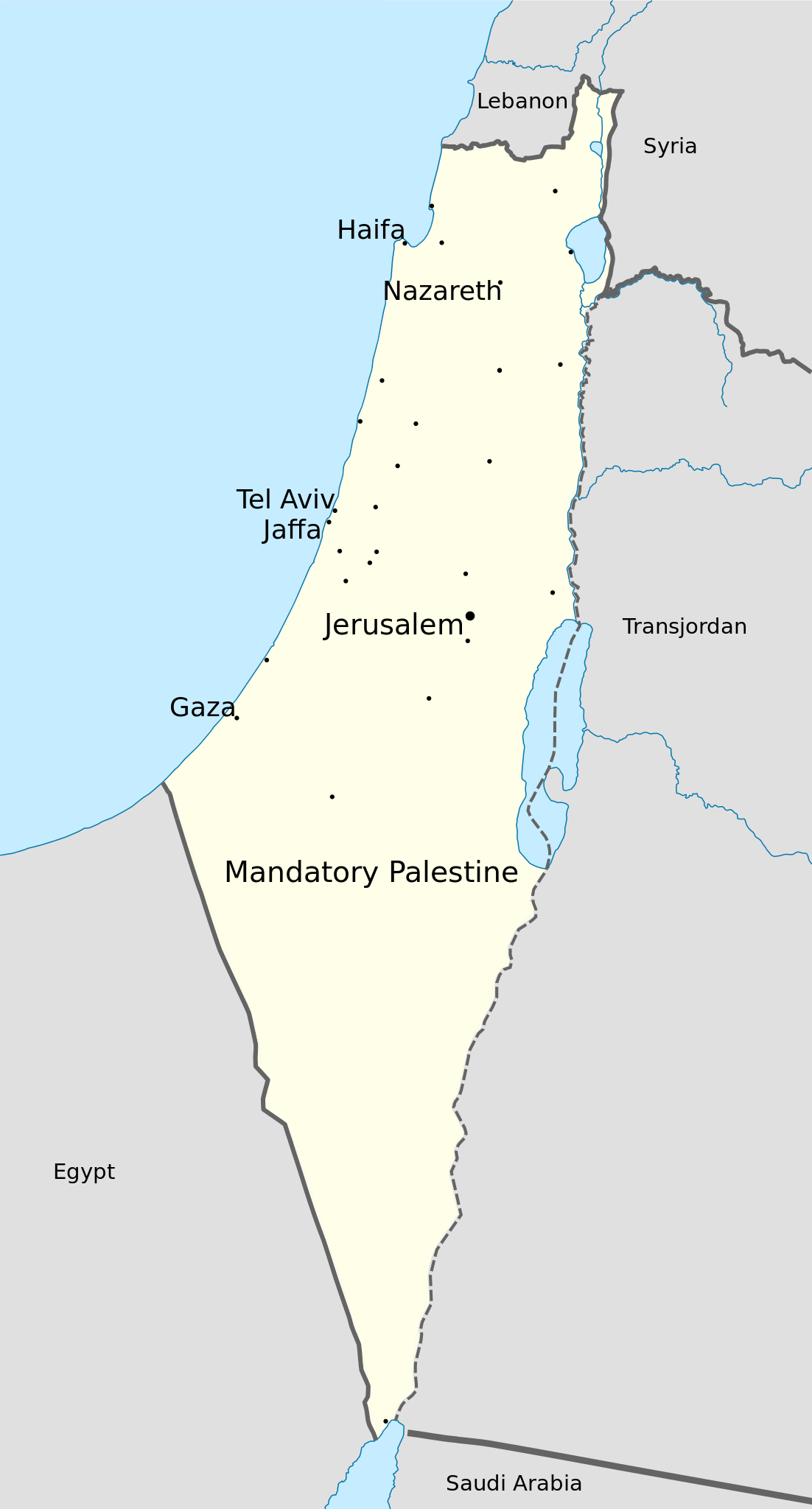
Map of Mandatory Palestine in 1946 | Wikimedia
The agenda was supposedly to prepare Palestine for independence, but the British imperialists treated their mandate as a colony; indeed, they had already, through the 1917 Balfour Declaration, agreed to the establishment of a Jewish national home in Palestine by the Zionist Organisation. A lengthy and thorough historical and legal examination by the UN on the origins and evolution of the Palestine problem establishes that this plan was opposed by many Jews, including Sir Edwin Montagu, the only Jewish member of the British cabinet. Yet it was eventually pushed through by the British government and accepted by the League of Nations, contrary to its own principles. As international law expert Professor Cattan, cited in the UN legal examination, says,
The Palestine Mandate was invalid…
The first ground of invalidity of the Mandate is that by endorsing the Balfour Declaration and accepting the concept of the establishment of a Jewish national home in Palestine it violated the sovereignty of the people of Palestine and their natural rights of independence and self-determination. Palestine was the national home of the Palestinians from time immemorial. The establishment of a national home for an alien people in that country was a violation of the legitimate and fundamental rights of the inhabitants. The League of Nations did not possess the power, any more than the British Government did, to dispose of Palestine, or to grant to the Jews any political or territorial rights in that country. In so far as the Mandate purported to recognize any rights for alien Jews in Palestine, it was null and void…
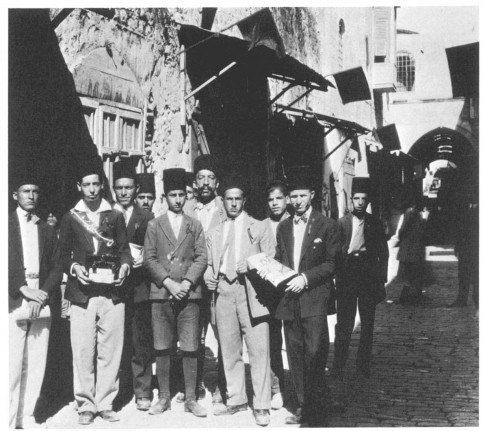
Palestinians in the old city of Jerusalem on Balfour Day mourning in 1929 | Khalil Raad (Wikimedia)
The UN noted, ‘That the Jews deserved sympathy was unquestionable. Even before the Nazi terror, this sympathy existed for the Jewish people among the Palestinian Arabs. The absence of racial rancour before the Balfour Declaration received emphasis in virtually every official report.’ Historian Arnold Toynbee, also cited in the UN study, remarked, for the next 30 years, under the protection of ‘British military power,’ Jewish immigration and land acquisition enabled the Jewish population to grow from less than 10% of the population to nearly a third, and their land ownership from 0.025% to 6.2%, displacing large numbers of Palestinians and leading to conflict. It enabled the immigrants to arm themselves with tanks and planes. Thus, British imperialism played a key role in all the violence that has followed.v
Mahatma Gandhi, despite his profound sympathy for persecuted Jews – which even extended to abandoning his rigid adherence to non-violence to argue that a war against Hitler would be justifiable – was adamant that it would be crime against humanity to hand over Palestine to the Zionists.vi
The two-state ‘solution’
When Britain handed over Palestine to the UN in 1947, the UN Special Committee on Palestine recommended partitioning Palestine into a Jewish state on 56% of its territory and an Arab state on 43%, with an international enclave around Jerusalem and Bethlehem.
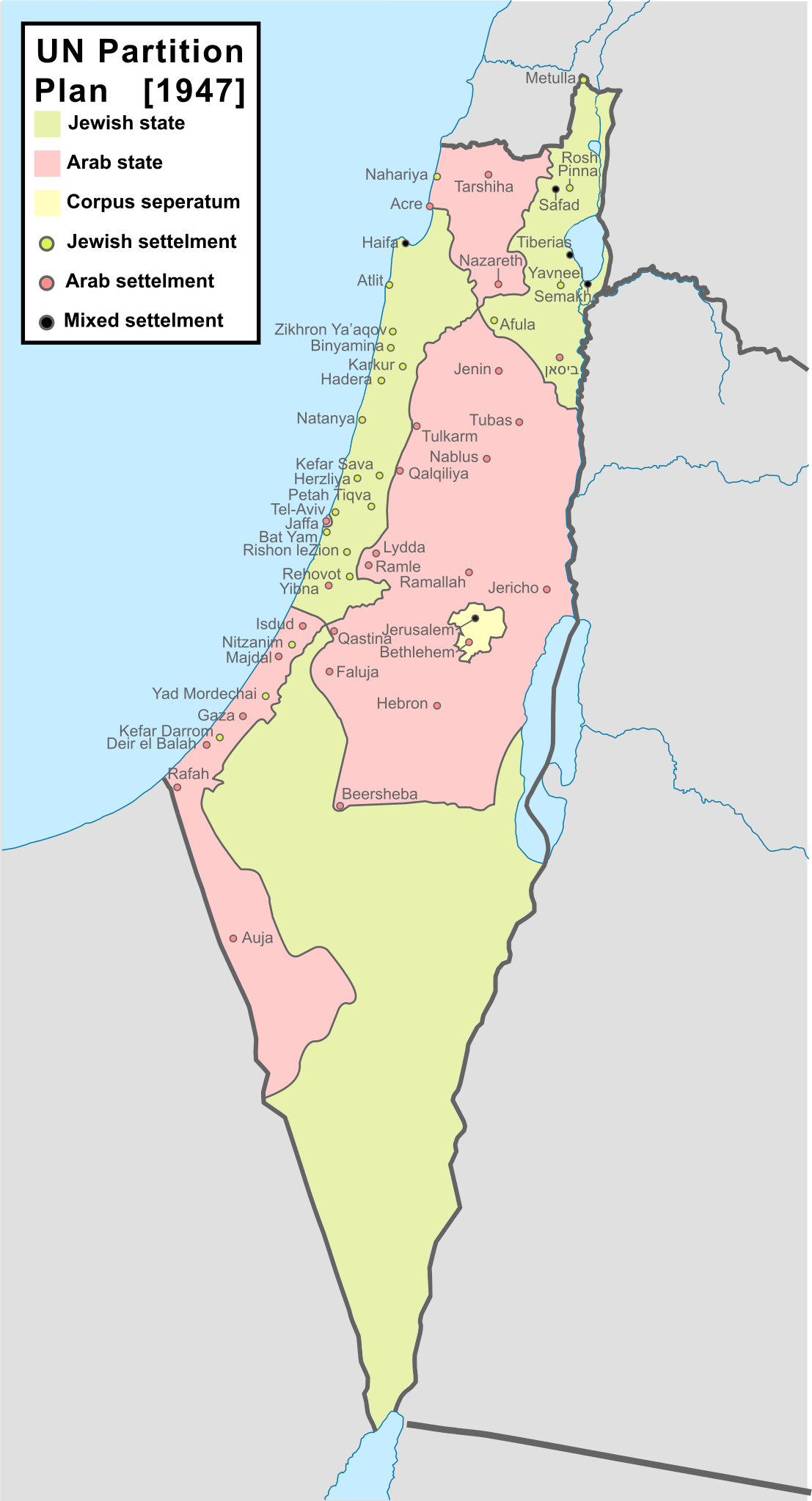
Map of the 1947 partition plan for Palestine | Wikimedia
The Arab states opposed the proposal on the grounds that it violated the UN Charter, and indeed if Britain had no right to gift Palestine to Zionist settler-colonialists, neither did the UN have the right to gift more than half of Palestine to them. Yet when the proposal was put before the UN General Assembly as Resolution 181 on 29 November 1947, it passed with 33 votes for, 13 against, and 10 abstentions. (India voted against.) Far from bringing an end to the violence, this resolution provided cover for Zionists to carry out the Nakba and violence that continues to this day, for which, therefore, the UN too bears responsibility.vii
Realising that the problem continued unabated, the UN appointed Count Folke Bernadotte, a Swedish diplomat who had arranged the release of around 31,000 prisoners from German concentration camps during World War II, to find solutions. His peace plan had three components: the right of return of Palestinian refugees, Jerusalem to be under international control, and permanent borders to prevent Israel from expanding. He submitted the proposal to the UN General Assembly on 16 September 1948, and the very next day was assassinated by Zionist terrorists of ‘Lehi’ aka the ‘Stern Gang’.viii His peace plan was never implemented and the assassins rose to prominent positions in Israel, but in December 1948, Resolution 194 of the UNGA incorporated the right of return of Palestinian refugees in accordance with already-established international law.ix
According to Ronnie Kasrils, who had been a Jewish anti-apartheid activist in South Africa, Afrikaner settlers established themselves in the 17th century ‘by force of arms and terror and the provocation of a series of bloody colonial wars of conquest;’ they forced the indigenous Africans off most of the land and into what came to be called Bantustans, but they still needed them as servants and workers. By contrast, settler colonialism in North America and Australia wanted to get rid of the indigenous people altogether, and this has been the aim of Zionism too, which is why when Kasrils visited the West Bank in 2004, he observed, ‘This is much worse than apartheid… The Israeli measures, the brutality, make apartheid look like a picnic.’x
Israeli historian Ilan Pappe explains that the main goal of Zionism was the ethnic cleansing of all of Palestine, which the movement coveted for its new state, and describes in detail the gruesome massacres by means of which almost 800,000 indigenous Palestinians – more than half the population – were driven from their homes. Their livelihoods, villages and urban neighbourhoods far beyond the area allotted by Resolution 181 were seized or destroyed, starting after the partition resolution in 1947 and peaking during the Nakba in 1948. Since then, ethnic cleansing – defined as a crime against humanity in the Rome Statute of the International Criminal Court (ICC) – has been carried out continuously by the Israeli state in Palestine.xi By 1949, Israel had annexed 78% of Palestine.
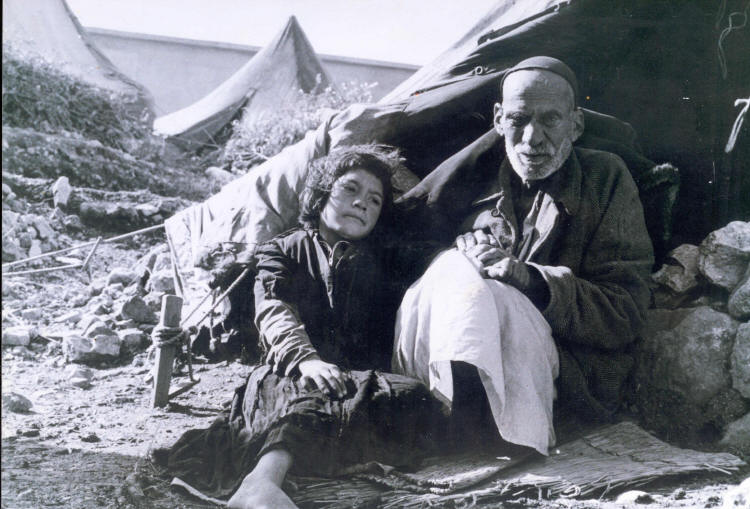
Palestinian refugees in 1948 | Wikimedia
Those who could not be expelled and became residents of Israel were subjected to an apartheid regime of discrimination, also a crime against humanity.xii In the 1967 war, the remaining parts of Palestine – the West Bank, East Jerusalem and Gaza Strip – were occupied by Israel. Negotiations between the Palestine Liberation Organisation (PLO) and Israeli government resulted in the Oslo Accords of 1993 and 1995, in which Palestinian self-government in 22% of Palestine was promised in exchange for Palestinian collaboration in ensuring Israeli security. However, annexation of Palestinian land never stopped, and the Palestinian Authority, set up to implement the accords, became an object of contempt for many Palestinians. The Gaza Strip, with over 70% of its inhabitants refugees from ethnic cleansing elsewhere, became an open-air prison with Israel controlling all its borders. Jewish settlements gradually took over the West Bank and East Jerusalem, converting the remaining Palestinian residential areas into ghettos and making a two-state solution impossible.xiii
The genocidal logic of settler colonialism
Moshé Machover, a founding member of the Israeli socialist group Matzpen, explains that the structural racism of the Israeli state is an inevitable consequence of its settler-colonial project. However, the government formed by Benjamin Netanyahu in December 2022 is more extreme than most previous governments, incorporating previously marginal fascists like Belazel Smotrich, Itamar Ben-Gvir and Miki Zohar in key cabinet posts. Machover quotes two Israeli experts on the history of fascism and Nazism: Professor Zeev Sternhell, who says that in statements made by two senior Israeli politicians, ‘we see not just a growing Israeli fascism but racism akin to Nazism in its early stages’; and Professor Daniel Blatman, who quoted Deputy Knesset Speaker Belazel Smotrich saying that Palestinians would become subjects without rights, and if they objected would be cleansed, and if they refused to leave would be exterminated, concluding that ‘I think it is Nazism in every way and fashion, even if comes from the school of the victims of historical Nazism.’xiv In fact, Netanyahu had already begun this process in 2018 when he passed the ‘Nation-State Law,’ which closely follows the Nazi Nuremberg Laws of 1935.xv Characterisation of this state as a fascist one has been widespread among Israeli left-wingers and left-liberals before and after the Hamas attacks.xvi
How do you force people to leave their homes and their land? By killing large numbers of them, inflicting injury and trauma on those who try to remain, demolishing their homes and depriving them of any source of livelihood: exactly the methods used by the Zionists in the ethnic cleansing of Palestine. The final solution to eliminate those who don’t leave is to exterminate them. In the Genocide Convention (1948), as in the Rome Statute of the ICC (2002), ‘genocide means any of the following acts committed with intent to destroy, in whole or in part, a national, ethnical, racial or religious group, as such: (a) Killing members of the group; (b) Causing serious bodily or mental harm to members of the group; (c) Deliberately inflicting on the group conditions of life calculated to bring about its physical destruction in whole or in part…’ According to legal experts, ‘Since 1947, there have been multiple “genocidal moments” where the Israeli settler-colonial regime has engaged in the mass killing of Palestinians, and their mass expulsion and annexation of their land causing severe physical or mental harm to the Palestinian community.’xvii Prior to 7 October, violence against Palestinians in the West Bank by Israeli security forces and armed settlers was already at a high level, and killings and expulsions escalated subsequently.xviii
What has changed since 7 October is that genocidal intent is now explicitly declared as state policy. Israeli Defence Minister Yoav Gallant declared the intention to destroy Palestinians as such in no uncertain terms on October 9th: ‘We are imposing a complete siege on Gaza. No electricity, no food, no water, no fuel. Everything is closed. We are fighting human animals, and we will act accordingly’. Israeli President Isaac Herzog said ‘It is an entire nation out there that is responsible. It is not true this rhetoric about civilians not being aware, not involved.’ Netanyahu quoted the first Book of Samuel in the Hebrew Bible to soldiers, saying, ‘Now go, attack the Amalekites and totally destroy all that belongs to them. Do not spare them; put to death men and women, children and infants, cattle and sheep, camels and donkeys.’xix When 2.3 million Palestinians in a sealed space, half of them children, are bombed relentlessly, including residential buildings, hospitals, ambulances, schools, mosques, churches, water reservoirs, bakeries, solar panels and UN facilities, this ‘textbook case of genocide’xx begins to look like the Nazi final solution.
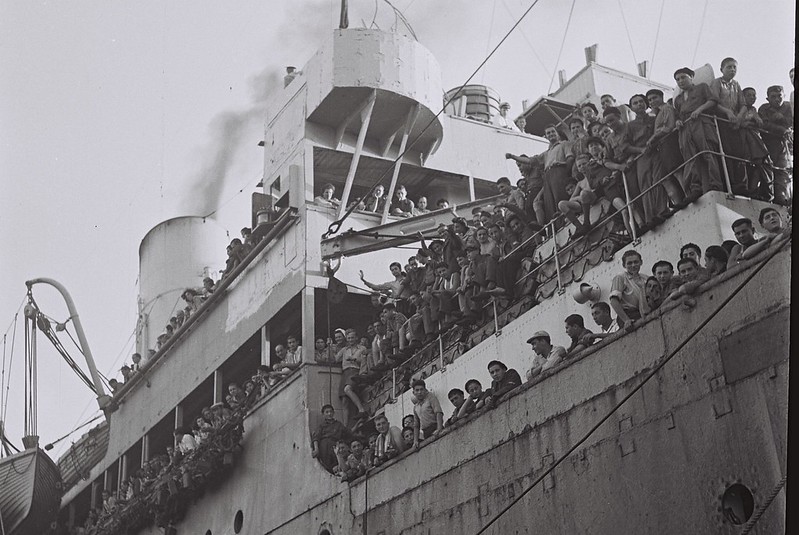
A British ship bringing European Jews to the port of Haifa in 1945 | Zoltan Kluger (CC BY-NC-SA 2.0 DEED)
These statements also reveal Israeli endorsement of the barbaric doctrine of collective punishment, which was used so pervasively by the Nazis. This is supplemented by the systematic use of ‘the big lie’; as Hitler explained, the very boldfaced nature of these fabrications renders them among the most powerful forms of public persuasion.xxi A good example of ‘the big lie’ is the claim that Hamas decapitated 40 babies in Kibbutz Kfar Azar during its incursion into Israel, which was repeated by news outlets like Fox News and the New York Post, politicians including President Biden, and actor Noah Schnapp and other social media users with large followings.
A fact check traced the rumour to two reports by Nicole Zedek of i24 News; in one, she said that soldiers had told her they saw babies with their heads cut off, and in another that soldiers told her they believed 40 babies/children were killed, and these two reports were conflated in subsequent social media posts. On October 11th, Netanyahu’s spokesperson told CNN that babies and toddlers had been decapitated, but the next morning CNN reported that the Israeli government could not confirm the claim. The White House too later told CNN that Biden had neither seen photos nor received confirmation that Hamas beheaded babies or children. During a tour through Kfar Azar, journalist Oren Ziv of +972 Magazine said he saw no evidence that Hamas beheaded babies, “and the army spokesperson or commanders also didn’t mention any such incidents,” he posted on X. Similarly Samuel Forey of Le Monde, while reporting from the ground in Kfar Azar, said ‘No one told me about beheadings, even less about beheaded children,’ and emergency services personnel he spoke with had not seen any decapitated bodies.xxii
What about Hamas?
The story of beheaded children was not only a big lie but also a clever one. By propagating the fiction that 40 babies had been decapitated in one kibbutz alone, Netanyahu’s government sought to justify the slaughter of thousands of children in Gaza. It also portrayed Hamas as akin to Al Qaeda and ISIS and thus a threat to Western countries. However, unlike Al Qaeda, IS and the Islamic Republic of Iran, which have transnational ambitions, Hamas is an Islamist national liberation group focused on Palestine. Like the Taliban in Afghanistan but perhaps less extreme, it seeks to establish an Islamic state. Yet there are Orthodox, Roman Catholic and Protestant Christians in Gaza, who have been worshipping at their own churches. The oldest was the Church of St Porphyrius, founded in the 5th century, which was sheltering its congregation and their Muslim neighbours, mostly women and children, when it was bombed by the Israeli state on October 19. Pope Francis prayed for the victims, but Biden saw no evil in Christians being massacred in the land of Jesus.xxiii
The complete failure of the Palestinian Authority even to stem the deteriorating conditions of Palestinians led to Hamas winning Palestinian legislative elections in 2006, and it took control of the Gaza Strip the following year. Opinion polls in March 2023 suggest that Palestinians support neither the PA led by Mahmoud Abbas nor Hamas, seeing both as corrupt (although support for PLO leader Marwan Barghouti, imprisoned by Israel, far outstrips both at 60%).xxiv Nonetheless, given Netanyahu’s support for Hamas, it is effectively the government in Gaza, i.e., not all Hamas members are fighters, many are civilian officials in charge of utilities and public services. It had previously launched rockets into Israel, but the scale of the attack on 7 October was unprecedented. What does international law say about this?
The UN affirms ‘the legitimacy of the struggle of peoples for independence, territorial integrity, national unity and liberation from colonial domination, apartheid and foreign occupation by all available means, including armed struggle,’xxv so Palestinians have the right to engage in armed struggle. However, even a national liberation war must abide by international law, which protects civilians, making Hamas’s attack on civilians a war crime. Is it terrorism? Yes, it is terrorism, defined as acts or threats of violence against unarmed civilians in pursuit of a political goal. These crimes and its right-wing Islamist ideology make it impossible for progressives to support Hamas.
However, according to this same definition, the Israeli state was established by acts of terrorism and has continuously been engaged in terrorism to this day. Moreover, it has violated international law on a vastly greater scale than Hamas, committing crimes against humanity and genocide, not just war crimes. In the words of Holocaust survivor Dr Gabor Maté, ‘The disproportion of power and responsibility and oppression is so markedly on one side that you take the worst thing you can say about Hamas, multiply it by a thousand times, and it still will not meet the Israeli repression and killing and dispossession of Palestinians.’xxvi
International reactions
The Israeli onslaught on Gaza sparked Palestine solidarity demonstrations throughout the world. Arab leaders who had done nothing to promote Palestine’s liberation for decades and had been normalising relations with Israel were jolted into putting this process on hold for fear of infuriating their people. The Chinese and Russian regimes, which have made clear their rejection of universal human rights and international law, nonetheless called for a ceasefire to allow for humanitarian aid. The UN, especially its Human Rights Council, spoke up for the human rights of Palestinians but was unable to protect even its own employees as over 100 of them were murdered by Israeli airstrikes.
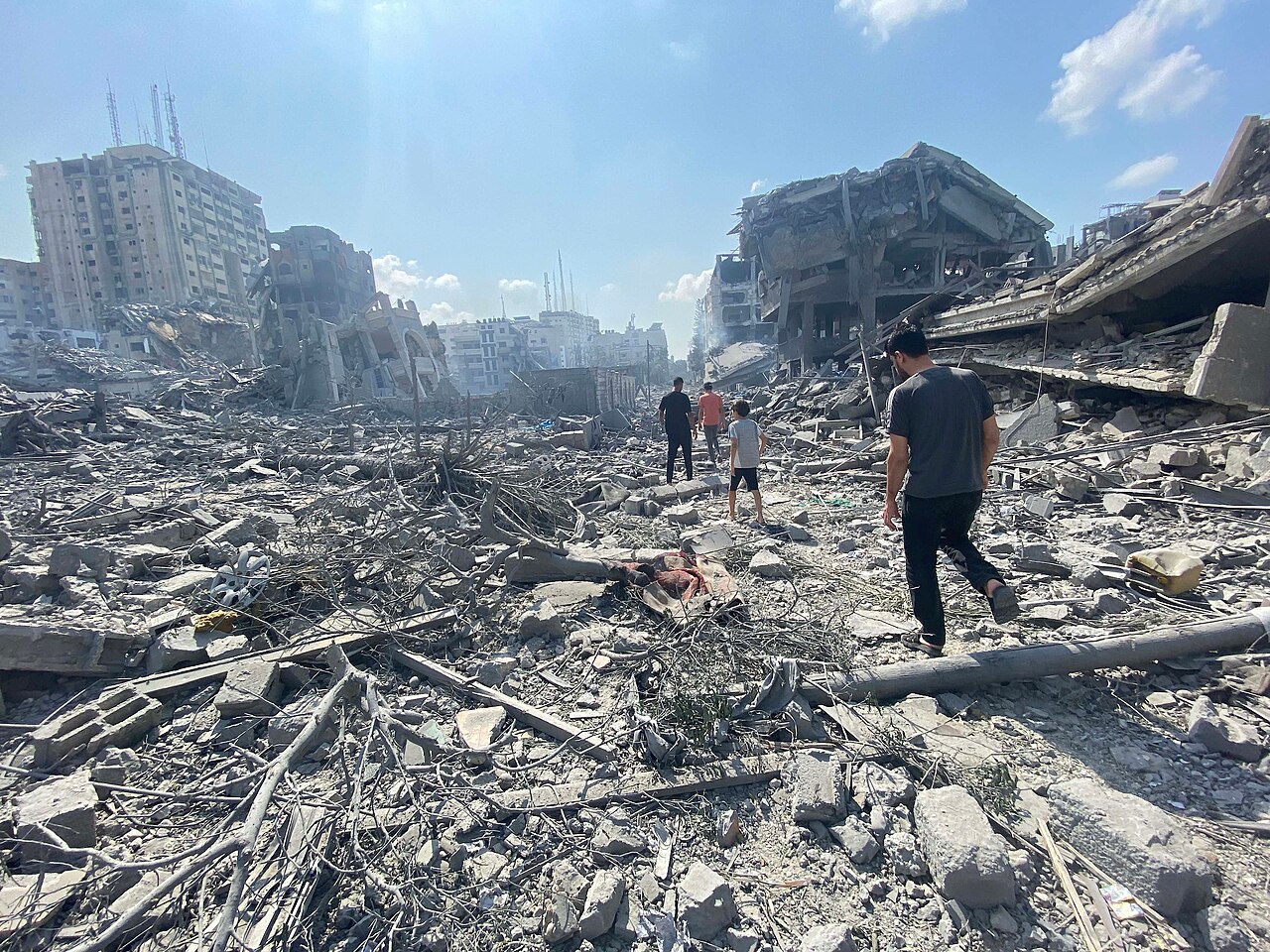
Gaza’s Rimal neighbourhood after Israeli airstrikes on October 9 | Wafa Agency/Wikimedia
Western leaders with very few exceptions, headed by Joe Biden and including Ursula von der Leyen, Olaf Scholz, Rishi Sunak, Keir Starmer, Justin Trudeau and Emmanuel Macron, stated that ‘Israel has the right to defend itself’, and in some cases pledged military supplies. Volodymyr Zelensky agreed that ‘Israel’s right to self-defense is indisputable’. There were a few – like EU foreign policy chief Josep Borrell – who criticised Israel for violating international law, but the rest gave a green light to the slaughter of Gaza’s civilians.
Two things make this position bizarre. First, while the vast majority of Israelis blame Netanyahu and his government for the attacks, these leaders endorsed Netanyahu’s extremist regime. Second, they all back Ukraine in its national liberation struggle against Russian colonialism, yet the positions of Ukraine and Palestine are almost identical. Putin denies the existence of Ukraine and is attempting to erase it from the face of the earth by ethnic cleansing and genocide just as Netanyahu denies the existence of Palestine and is attempting to erase it by ethnic cleansing and genocide. The timelines are different: the Zionist assault on Palestine started in 1920, whereas Putin’s assault on Ukraine started in 2014, although there were earlier bouts of genocide in Ukraine and Crimea, under Tsarism, Stalin and the Nazis. And the Ukraine struggle is led by a democratically elected government whereas there is no such government in Palestine. Yet the similarities are striking.
So anyone who argues that the Israeli regime colonising Palestine has the ‘right’ to defend itself from a national liberation struggle by killing Palestinians in Palestine would logically have to argue that the Russian regime colonising Ukraine has the ‘right’ to defend itself from the national liberation struggle there by killing Ukrainians in Ukraine. Biden’s reaction is particularly ghoulish. With the US already having provided billions of dollars that have been used to slaughter thousands of Palestinian children, he wants US taxpayers to provide $14 billion more to Israel. For what? To slaughter tens of thousands more children? This position led the Center for Constitutional Rights to issue an emergency legal briefing paper on 18 October warning that ‘The United States is not only failing to uphold its obligation to prevent the commission of genocide, but there is a plausible and credible case to be made that the United States’ actions to further the Israeli military operation, closure, and campaign against the Palestinian population in Gaza, rise to the level of complicity in the crime under international law.’xxvii
One explanation for the blatant double standard involved in supporting the colonial regime in Palestine and the liberation struggle in Ukraine is racism. Racism was entrenched in Western and Eastern imperialist powers, since domination, enslavement and extermination of other peoples had to be justified by deeming them inferior, and antisemitism was a widespread form of racism. One response to antisemitism from Jews in Eastern Europe in the late 19th century was an initiative to join the imperialist oppressors by creating their own settler-colony in Palestine: Zionism. As Edward Said shows, ‘Zionism essentially saw Palestine as the European imperialist did, as an empty territory “filled” with ignoble or perhaps even dispensable natives; it allied itself, as Chaim Weizmann quite clearly said after World War I, with the imperial powers in carrying out its plans for establishing a new Jewish state in Palestine.’xxviii Thus Zionist racism against Palestinians, Arabs and Muslims resonates with the imperial racism of the Western powers supplemented by rampant Islamophobia (the inaccurate but widely-used term for anti-Muslim racism) whipped up after 9/11 by the ‘war on terror’. Zelensky’s support for Israel is an anomaly, since Ukraine is a former colony, not an imperial power, and is explained by his Zionism.
The other driver of Western support for Israeli atrocities is guilt about the role their countries played in the Holocaust: Germany as the home of Nazism, collaborators in the countries it occupied, and Britain and the US for failing to save Jewish lives by opening their borders to refugees. This has given the Israeli state a powerful means of manipulating them by investing heavily in extremely sophisticated information warfare or ‘hasbara,’ described as ‘communication calculated to influence cognition and behavior by manipulating perceptions of a cause or position with one-sided arguments, prejudicial substance, and emotional appeals… Although hasbara includes efforts to impede access to information through a wide variety of techniques…, it focuses on limiting the receptivity of audiences to information’ contradicting its narrative.xxix Key features of hasbara are the demonisation of Palestinians, Arabs and Muslims and the message that anti-Zionism constitutes antisemitism. It has resulted in widespread acceptance of the open-ended International Holocaust Remembrance Alliance (IHRA) ‘Working Definition of Antisemitism’, which includes ‘claiming that the existence of a State of Israel is a racist endeavor’ and ‘drawing comparisons of contemporary Israeli policy to that of the Nazis’ as examples of antisemitism. The IHRA suggests that antisemitic acts as defined by them should be criminalised. xxx
In Palestine, hasbara entails the targeted assassination of journalists, which has been going on for decades, and includes the murder of at least 35 journalists since 10/7, some with their entire families, and the bombing of roughly 50 media headquarters in Gaza. In the West, it includes ‘dehumanizing rhetoric that has served to justify ethnic cleansing of Palestinians’, ‘Double-standards, inaccuracies and fallacies’ and ‘inflammatory language that reinforces Islamophobic and racist tropes.’xxxi
The conflation of antisemitism with anti-Zionism has resulted in racist attacks on Palestinians, Arabs and Muslims even as white neo-Nazi attacks on Jews are ignored. In Germany, this discourse has served to project guilt for the Holocaust onto these immigrants whose communities had no responsibility whatsoever for it, although, unfortunately, some Palestinians and their supporters have indeed been guilty of antisemitic views. Public policy in Germany shifted funding from fighting racism to supposedly fighting Muslim antisemitism, but police and intelligence statistics showed that in 2017, for example, there were 28 antisemitic physical attacks, around 95% of them by white Germans, almost 2000 attacks on refugees, around 900 on German Muslims, more than 100 attacks on refugee aid workers and 205 criminal acts (including shootings) against parliamentary politicians who supported refugees, asylum rights and anti-racism policies.xxxii
It is depressing that Germans who vowed ‘Never again’ after the Holocaust are now in danger of complicity in another genocide by sending arms to Israel while targeting immigrant communities in Germany with racist violence. The crackdown on freedom of expression in the name of fighting against antisemitism has reached such absurd lengths that a Jewish Israeli woman was detained for standing alone in a public square holding a sign denouncing the ongoing war waged by her own country. In an open letter, a group of Jewish writers, academics, journalists and cultural workers living in Germany wrote, ‘As Jews, we reject this pretext for racist violence and express full solidarity with our Arab, Muslim, and particularly our Palestinian neighbors… What frightens us is the prevailing atmosphere of racism and xenophobia in Germany, hand in hand with a constraining and paternalistic philo-Semitism. We reject in particular the conflation of anti-Semitism and any criticism of the state of Israel… If this is an attempt to atone for German history, its effect is to risk repeating it.’xxxiii
At the same time, more than 300 Ukrainian scholars, political and labour activists and artists published an open letter expressing their solidarity with ‘the people of Palestine who for 75 years have been subjected to and resisted Israeli military occupation, separation, settler colonial violence, ethnic cleansing, land dispossession and apartheid.’ While condemning the attack on Israeli civilians by Hamas, which they call ‘a reactionary Islamist organisation,’ they argue, ‘Yet this is no justification for the collective punishment of Palestinian people, identifying all residents of Gaza with Hamas and the indiscriminate use of the term “terrorism” applied to the whole Palestinian resistance. Nor is this a justification for continuation of the ongoing occupation.’ Comparing the Palestinian struggle for self-determination with their own struggle in Ukraine, they continue,
Civilians in Ukraine are shelled daily, in their homes, in hospitals, at bus stops, in queues for bread. As a result of the Russian occupation, thousands of people in Ukraine live without access to water, electricity or heating, and it is the most vulnerable groups that are mostly affected by the destruction of critical infrastructure. In the months of the siege and heavy bombardment of Mariupol, there was no humanitarian corridor.
Watching the Israeli targeting of civilian infrastructure in Gaza, the Israeli humanitarian blockade and occupation of land resonates especially painfully with us. From this place of pain of experience and solidarity, we call on our fellow Ukrainians globally and all the people to raise their voices in support of the Palestinian people and condemn the ongoing Israeli mass ethnic cleansing.
Rejecting their own government’s unconditional support for Israel, which is a retreat from Ukraine’s traditional support for the Palestinian right to self-determination, they urge implementation of the UNGA resolution calling for a ceasefire, an end to the blockade of Gaza and attacks on Palestinians in the West Bank, and recognition of the right of displaced Palestinians to return to their lands. They end by saying, ‘We have witnessed the world uniting in solidarity for the people of Ukraine and we call on everyone to do the same for the people of Palestine.’xxxiv
This moving expression of people-to-people solidarity is a fitting response to the sentiments expressed by civilians in Gaza as Russian missiles started targeting civilians in Ukraine in February 2022. Gaza residents Hadya al-Husary and Wael al-Ashy compared what was happening in Ukraine to their own experience under Israeli bombs and called on civilians ‘to demonstrate against the Russian aggression against Ukraine by launching online solidarity campaigns. “We may be different in race, religion, and language, but we are all humans,” Ashy said, adding that “We all express our solidarity with the Ukrainian people.” Husary added: “We hope that the Russian war would end soon, so civilians in Ukraine can return to their lives.”xxxv
What is to be done?
As the death toll in Gaza mounted and efforts to push through a ceasefire resolution in the UN Security Council failed, a resolution proposed on 26 October by Jordan in the UN General Assembly and backed by over 45 member states called for ‘an immediate, durable and sustained humanitarian truce’ between Israeli forces and Hamas militants in Gaza, and demanded ‘continuous, sufficient and unhindered’ provision of life-saving supplies and services for civilians trapped inside the enclave.xxxvi It received overwhelming support, with 120 states voting in favour, including Belgium, France, Ireland, New Zealand, Norway, Portugal and Spain. Other Western powers like Australia, Denmark, Germany, Italy and the UK were among the 45 which abstained, as was India.xxxvii Indian Congress leader Priyanka Gandhi said she was shocked and ashamed at India’s abstention, saying,
To refuse to take a stand and watch in silence as every law of humanity is pulverised, food, water, medical supplies, communication and power is cut off to millions of people and thousands of men, women and children in Palestine are being annihilated goes against everything our country has stood for throughout its life as a nation.xxxviii
Others have pointed out, however, that there is nothing surprising about this stance, since the virulent Islamophobia of the current Indian government resonates with that of the Israeli state:
In keeping with the environment of a disregard for the fundamental right to expression that now pervades the country, the government of India stand on the war has been turned into a prohibition on showing solidarity with Palestine… There is a complete conflation of domestic Islamophobia with Israel’s war against the people of Gaza.
It has been noted worldwide that the most virulent of Islamophobic posts since the war began have come from India. These are the same groups who express an admiration for Hitler, which makes Mein Kampf popular in India, a book now joined in bookshops by Gopal Godse’s Why I killed Gandhi. There is no irony here; it is all the same world-view.xxxix
A rump of 14 states, including Israel and the United States, voted against the resolution. After a month of carnage, cold-shouldering from Arab and Muslim leaders and persistent protests from their own people, Biden and Secretary of State Anthony Blinken started pleading with Netanyahu to have pauses in the killing: pleas that were ignored by Netanyahu. Thanks to the heroism of Gaza’s reporters, the barbarism of the fascist Israeli state as it tortures and kills millions of Palestinians, half of them children, is visible to all the world, and it should be clear to anyone with an iota of humanity that the immediate need is for a durable ceasefire, binding on both sides, an exchange of hostages (since that is what Israel’s Palestinian prisoners are), and a huge influx of humanitarian supplies to all parts of Gaza.
Western leaders and media have also issued weak calls for Israel to abide by international humanitarian law, applicable only in times of war. This covers up Israeli violations of international human rights law and international criminal law (the Genocide Convention and Rome Statute of the ICC), which are applicable in peacetime as well as wartime, prior to the Hamas attack. In fact, international criminal law allows for the prosecution of individuals, both perpetrators and those with command responsibility for violations; thus on 13 November, the Center for Constitutional Rights filed a lawsuit against Biden, Blinken and Defense Secretary Lloyd Austin charging them with failure to prevent genocide and complicity in genocide.xl
Western politicians have tried to resurrect the so-called two-state solution, which had long been dead and buried by the Israeli state; today it can only be achieved by waging a bloody war to evict over 700,000 Israeli settlers, many of them armed, while the apartheid state of Israel supports them with all the weapons at its disposal. Even if it was not impractical, it would be unjust. The colonial Israeli state has no more right to rule Palestine than the British state had to rule India, the French state to rule Algeria, or the German state to rule Namibia, where an independence struggle by the Herero was met with genocide.xli
As Israeli soldier-turned-peace-activist Miko Peled argues, there will be no peace without justice, and justice entails an independent democratic state of Palestine with equal rights for all in the whole of historic Palestine. The main obstacle to peace is the apartheid state of Israel, and it can be defeated in the same way as apartheid South Africa: by sanctions.xlii Blake Alcott explains that one democratic state was the vision that inspired Palestinians from 1918 onward, and was supported by 99% of Palestinians in 1974, after which the leadership abandoned it. However, a significant section of Palestinians and some Israeli Jews continued to hold to it. Palestinian refugees and their descendants would have the right to citizenship, as would Israeli Jews currently in the territory.xliii The One Democratic State Campaign explains how it would work, and has a Manifesto that can be signed by international supporters.xliv
The BDS movement provides a path towards that goal. In 2005, 170 Palestinian unions, refugee networks, women’s organisations, professional associations, popular resistance committees and other Palestinian civil society organisations called for boycotts, divestment and sanctions against Israel until it complied with international law by meeting three demands: (1) Ending Israeli occupation and colonisation of the Palestinian Occupied Territories and dismantling the ‘apartheid’ wall that cuts deep into Palestinian land; (2) Recognising the fundamental rights of the Arab-Palestinian citizens of Israel to full equality; (3) Respecting, protecting and promoting the rights of Palestinian refugees to return to their homes and properties as stipulated in UN Resolution 194.xlv All these demands are supported by international law; to say that Palestinians are not entitled to these universal rights is racist. BDS describes itself as ‘an inclusive, anti-racist human rights movement that is opposed on principle to all forms of discrimination, including anti-semitism and Islamophobia,’ and is completely non-violent.
As the genocide of Palestinians in Gaza proceeds, Arab and Muslim states proclaiming their support for Palestinians should be pressed by their people to boycott Israel completely as well as any companies doing business with Israel or investing in it. Campaigners elsewhere can do the same as individuals as well as press their own governments to do so. Eventually the Israeli state will suffer the same fate as apartheid South Africa.
What about antisemitism?
It is indeed important to condemn and combat antisemitism, one of the oldest forms of racism that is still rampant today, but combating it effectively requires an accurate definition of it.
On 25 March 2021, the Jerusalem Declaration on Antisemitism (JDA) was presented by a group of over 200 eminent Jewish scholars of antisemitism studies and related fields, who felt that the IHRA definition weakened the fight against antisemitism by causing confusion and generating controversy. They defined antisemitism as ‘discrimination, prejudice, hostility or violence against Jews as Jews (or Jewish institutions as Jewish),’ and made it clear that ‘while antisemitism has certain distinctive features, the fight against it is inseparable from the overall fight against all forms of racial, ethnic, cultural, religious and gender discrimination’. They specifically excluded ‘Supporting the Palestinian demand for justice and the full grant of their political, national, civil and human rights… Criticizing or opposing Zionism as a form of nationalism… Evidence-based criticism of Israel as a state’ and comparing ‘Israel with other historical cases…’ and ‘Boycott, divestment and sanctions’ against Israel as instances of antisemitism.xlvi
Thus, for example, if we argue that Israel is an apartheid state, we should make it clear that our objection is not simply to a Jewish state but to any state linked to any religion, which will inevitably be an apartheid state because it will discriminate against people of other faiths and none. And if we compare the policies of Netanyahu’s 2022 government with those of the Nazis, we need to provide evidence, as Israeli Professors Zeev Sternhell and Daniel Blatman do.xlvii
Jews are human beings like everyone else, they range from the best of humanity to the worst. There are Jewish fascists like Netanyahu and his cabinet who deserve prosecution in the ICC for crimes against humanity and genocide. There are also Jewish scholars and human rights activists, including rabbis, who deserve gratitude and admiration for their steadfast pursuit of truth and justice in Palestine. Indeed, the pivotal role they have played in the current Palestine solidarity campaign makes nonsense of the identification of Jews with the state of Israel by both antisemites and Zionists.
Antisemitism is racism against Jews. Zionism is racism against Palestinians, Arabs and Muslims. Racism against any group erodes our humanity by blocking our compassion for oppressed human beings who differ from us in some way. If there is any glimmer of light in the darkness of this time, it comes from the multitudes of people around the world demanding a ceasefire and adequate humanitarian aid to Gaza, including 66 per cent of the people of the United States and 80 per cent of Democratic Party supporters. Despite the racism of their leaders, their humanity is not dead.
References
i Haaretz, 8 October 2023. https://www.haaretz.com/opinion/editorial/2023-10-08/ty-article-opinion/netanyahu-bears-responsibility/0000018b-0b9d-d8fc-adff-6bfd1c880000
ii The Jerusalem Post, ‘Israelis blame gov’t for Hamas massacre, say Netanyahu must resign – poll,’ 13 October 2023. https://www.jpost.com/israel-news/article-767880
iii Adam Raz, 20 October 2023, ‘A brief history of the Netanyahu-Hamas alliance,’ Haaretz. https://www.haaretz.com/israel-news/2023-10-20/ty-article-opinion/.premium/a-brief-history-of-the-netanyahu-hamas-alliance/0000018b-47d9-d242-abef-57ff1be90000
iv Gideon Levy, ‘Israel can’t imprison two million Gazans without paying a cruel price,’ Haaretz, 9 October 2023. https://www.haaretz.com/opinion/2023-10-09/ty-article-opinion/.premium/israel-cant-imprison-2-million-gazans-without-paying-a-cruel-price/0000018b-1476-d465-abbb-14f6262a0000
v United Nations, ‘The Question of Palestine: Origins and Evolution of the Palestine Problem 1917–1947, Part 1.’ https://www.un.org/unispal/history2/origins-and-evolution-of-the-palestine-problem/part-i-1917-1947/
vi Arjun Sengupta, ‘Why Mahatma Gandhi opposed a Jewish nation-state in Palestine,’ Indian Express, 12 October 2023. https://indianexpress.com/article/explained/explained-history/gandhi-opposed-jewish-nation-state-palestine-8975964/
vii Interactive Encyclopedia of the Palestinian Question, ‘UN Partition Plan, 1947: Paving the Way to the Impending Nakba.’ https://www.palquest.org/en/highlight/159/un-partition-plan-1947
viii Muhammad Hussein, ‘Remembering the Zionists’ assassination of UN Palestine mediator Count Folke Bernadotte,’ Middle East Monitor, 17 September 2023. https://www.middleeastmonitor.com/20230917-remembering-the-assassination-of-count-bernadotte/
ix Gail G. Boling, ‘Palestinian refugees and the right of return: An international law analysis,’ BADIL – Information and Discussion Brief Issue No. 8, January 2001. https://www.badil.org/phocadownload/Badil_docs/Working_Papers/Brief-No-08.htm
x Chris McGreal, ‘Brothers in arms – Israel’s secret pact with Pretoria,’ The Guardian, 7 February 2006. https://www.theguardian.com/world/2006/feb/07/southafrica.israel
xi Ilan Pappe, The Ethnic Cleansing of Palestine, Oneworld Publications Limited, 2006. https://oneworld-publications.com/work/the-ethnic-cleansing-of-palestine/
xii Amnesty International, ‘Israel’s Apartheid Against Palestinians: Cruel System of Domination and Crime Against Humanity,’ February 2022. https://www.amnesty.org/en/latest/campaigns/2022/02/israels-system-of-apartheid/
xiii Adam Entous, ‘The maps of Israeli settlements that shocked Barack Obama,’ The New Yorker, 9 July 2018. https://www.newyorker.com/news/news-desk/the-map-of-israeli-settlements-that-shocked-barack-obama
xiv Moshé Machover, ‘Why Israel is a racist state,’ Matzpen, October 2018. https://www.matzpen.org/english/wp-content/uploads/2018/10/IsraelRacism-machover-2018.pdf
xv Susan Abulhawa, ‘Israel’s “nation-state law” parallels the Nazi Nuremberg laws,’ Al Jazeera, 26 July 2018. https://www.aljazeera.com/opinions/2018/7/26/israels-nation-state-law-parallels-the-nazi-nuremberg-laws
xvi Alberto Toscano, ‘The war on Gaza and Israel’s fascism debate,’ Verso blog, 19 October 2023. https://www.versobooks.com/en-gb/blogs/news/the-war-on-gaza-and-israel-s-fascism-debate
xvii Center for Constitutional Rights, ‘Emergency Legal Briefing: Israel’s unfolding crime of genocide of the Palestinian people and US failure to prevent and complicity in genocide,’ 18 October 2023. https://ccrjustice.org/sites/default/files/attach/2023/10/Israels-Unfolding-Crime_ww.pdf
xviii Medecins sans Frontieres, Israeli forces and settlers ramp up violence against Palestinians in West Bank, 9 November 2023. https://www.msf.org/israeli-forces-and-settlers-ramp-violence-against-palestinians-west-bank
xix Noah Lannard, ‘The dangerous history behind Netanyahu’s Amalek rhetoric,’ Mother Jones, November 3, 2023. https://www.motherjones.com/politics/2023/11/benjamin-netanyahu-amalek-israel-palestine-gaza-saul-samuel-old-testament/
xx Raz Segal, ‘A Textbook Case of Genocide,’ Jewish Currents, 13 October 2023. https://jewishcurrents.org/a-textbook-case-of-genocide
xxi Cameron Van der Graaf, ‘The “Big Lie” exposed: A rhetorical analysis of Nazi-German in 22 lessons,’ https://www.hoover.org/news/big-lie-exposed-rhetorical-analysis-nazi-german-22-lessons
xxii Sara Swann, ‘How media outlets and politicians amplified uncorroborated reports of beheaded babies in Israel,’ Poynter, October 24, 2023. https://www.poynter.org/fact-checking/2023/hamas-behaded-babies-israel-unconfirmed-reports-spread/
xxiii Lorraine Mallinder, ‘Under Israeli attack: Who are the Christians of Gaza?’ Al Jazeera, 1 November 2023. https://www.aljazeera.com/news/2023/11/1/under-israeli-attack-who-are-the-christians-of-gaza
xxiv Palestinian Center for Policy and Survey Research, Public Opinion Poll No. (87) https://pcpsr.org/en/node/938
xxv United Nations, ‘The Question of Palestine. Right of Peoples to self-determination/Struggle by all available means,’ GA Resolution 1514 (XV) of 14 December 1960. https://www.un.org/unispal/document/auto-insert-184801/
xxvi ‘Dr Gabor Maté speaks out on Israel and Palestine.’ https://www.youtube.com/watch?v=uXrFzqu4QHk
xxvii Center for Constitutional Rights, ‘Emergency Legal Briefing: Israel’s unfolding crime of genocide of the Palestinian people and US failure to prevent and complicity in genocide,’ 18 October 2023. https://ccrjustice.org/sites/default/files/attach/2023/10/Israels-Unfolding-Crime_ww.pdf
xxviii Edward Said, 1979. ‘Zionism from the standpoint of its victims’ (excerpts). https://www.jewishvoiceforpeace.org/wp-content/uploads/2016/06/Edward-Said-Excerpt.pdf
xxix Chas W Freeman, n.d., ‘Hasbara and the control of narrative as an element of strategy,’ Middle East Policy Council. https://mepc.org/speeches/hasbara-and-control-narrative-element-strategy
xxx International Holocaust Remembrance Alliance (2016) ‘Working Definition of Antisemitism’. https://www.holocaustremembrance.com/resources/working-definitions-charters/working-definition-antisemitism
xxxi ‘A Statement by Journalists: We condemn Israel’s killing of journalists in Gaza and urge integrity in Western media coverage of Israel’s atrocities against Palestinians.’ November 9, 2023. https://www.protect-journalists.com/
xxxii Anna-Esther Younes, ‘Fighting Anti-Semitism in Contemporary Germany,’ Islamophobia Studies Journal, 5 (2), Fall 2020, pp.249–266.
xxxiii n+1 Magazine, ‘Freedom for the One Who Thinks Differently: An open letter from a group of Jewish artists, writers and scholars in Germany,’ 8 November 2023. https://www.nplusonemag.com/online-only/online-only/freedom-for-the-one-who-thinks-differently/
xxxiv Ukraine-Palestine Solidarity Group, ‘Ukrainian letter of solidarity with the Palestinian people,’ 8 November 2023. https://www.aljazeera.com/opinions/2023/11/8/ukrainian-letter-of-solidarity-with-the-palestinian
xxxv Sally Ibrahim, ‘Palestinians in Gaza Strip express solidarity with Ukrainians amid Russian invasion,’ The New Arab, 27 February 2022. https://www.newarab.com/news/gazans-solidarity-ukrainians-amid-russian-attack
xxxvi United Nations, ‘UN General Assembly adopts Gaza resolution calling for immediate and sustained “humanitarian truce”’, 26 October 2023. https://news.un.org/en/story/2023/10/1142847
xxxvii Al Jazeera, ‘UNGA calls for humanitarian truce in Israel-Gaza war: How countries voted,’ 27 October 2023. https://www.aljazeera.com/news/2023/10/27/unga-calls-for-humanitarian-truce-in-israel-hamas-war-how-countries-voted
xxxviii India Today, ‘“Ashamed that…”: Priyanka Gandhi on India abstaining from UN vote on Gaza truce,’ October 28, 2023. https://www.indiatoday.in/india/story/israel-hamas-war-priyanka-gandhi-india-abstaining-from-unga-vote-ashamed-2454788-2023-10-28
xxxix C. Rammanohar Reddy, ‘With India’s callousness towards Palestine, a little bit of the country’s soul has been washed away,’ Scroll.in, 12 November 2023. https://scroll.in/article/1058901/why-israels-war-on-gaza-has-incited-an-outpouring-of-virulent-islamophobia-in-india
xl Prem Thakker, ‘Palestinians sue Biden for failing to prevent genocide in Gaza,’ The Intercept, November 13, 2023. https://theintercept.com/2023/11/13/gaza-lawsuit-biden-israel-genocide/
xli Reinhart Kössler, 2008. ‘Entangled history and politics: Negotiating the past between Namibia and Germany,’ Journal of Contemporary African Studies, 26(3), 313–339.
xlii Miko Peled interviewed by Steve Clemens in ‘The Bottom Line,’ Al Jazeera, 3 November 2023. https://www.aljazeera.com/program/the-bottom-line/2023/11/3/should-palestinians-israelis-live-equally-in-one-state
xliii Blake Alcott, ‘One Democratic State: What’s happening?’ Palestine Chronicle, April 5, 2018. https://www.palestinechronicle.com/ods-whats-happening/
xliv One Democratic State Campaign Manifesto. https://onestatecampaign.org/all/en-manifesto/
xlv BDS, ‘What is BDS?’ https://bdsmovement.net/what-is-bds
xlvi Jerusalemdeclaration.org (2021) ‘The Jerusalem Declaration on Antisemitism’. https://jerusalemdeclaration.org/
xlvii Moshé Machover, ‘Why Israel is a racist state,’ Matzpen, October 2018. https://www.matzpen.org/english/wp-content/uploads/2018/10/IsraelRacism-machover-2018.pdf
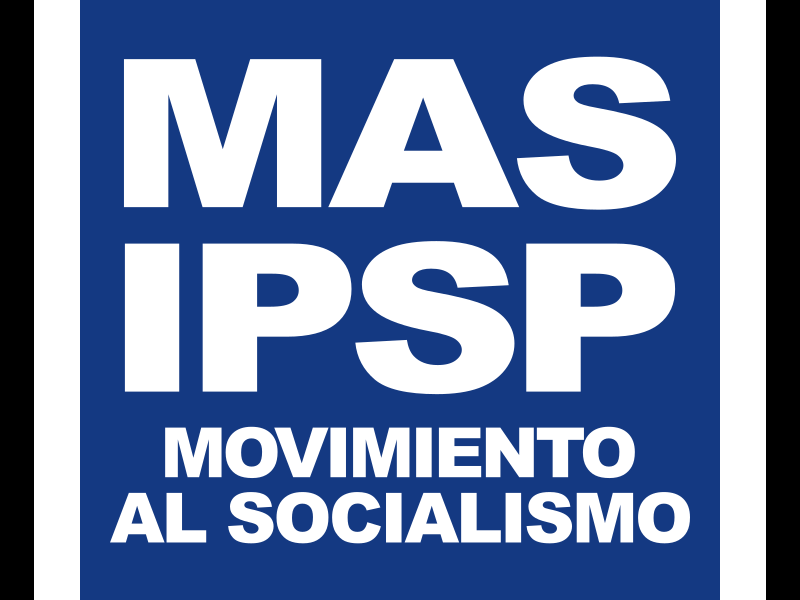
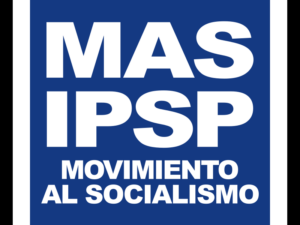 It is undeniabe that Luis Arce, the President of Bolivia, is no longer responding to the demands of his ex-boss, former President Evo Morales. Confrontations between the two men appear to be turning into what in Bolivia we call a ch’ampa war.
It is undeniabe that Luis Arce, the President of Bolivia, is no longer responding to the demands of his ex-boss, former President Evo Morales. Confrontations between the two men appear to be turning into what in Bolivia we call a ch’ampa war. 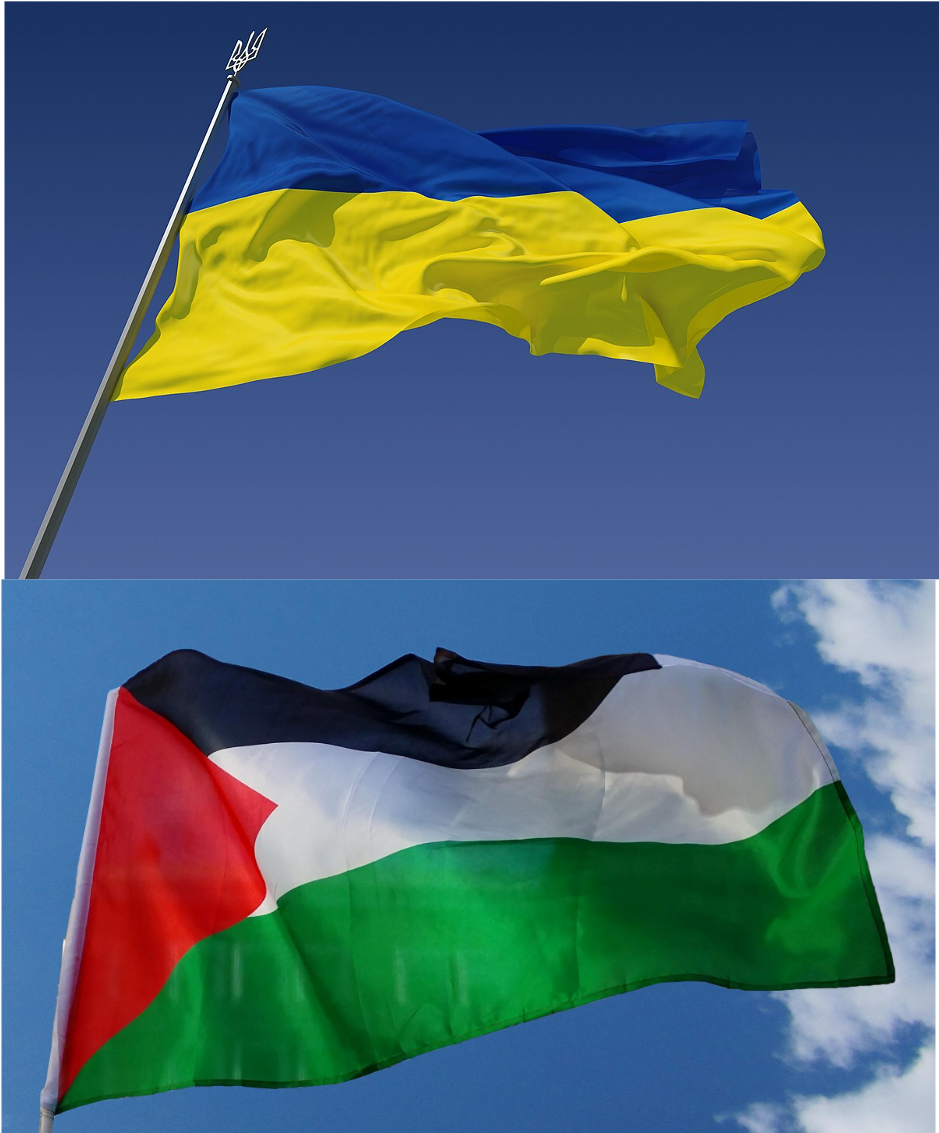
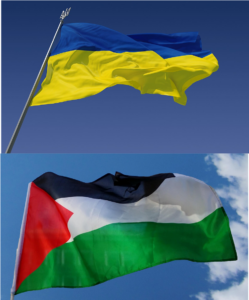
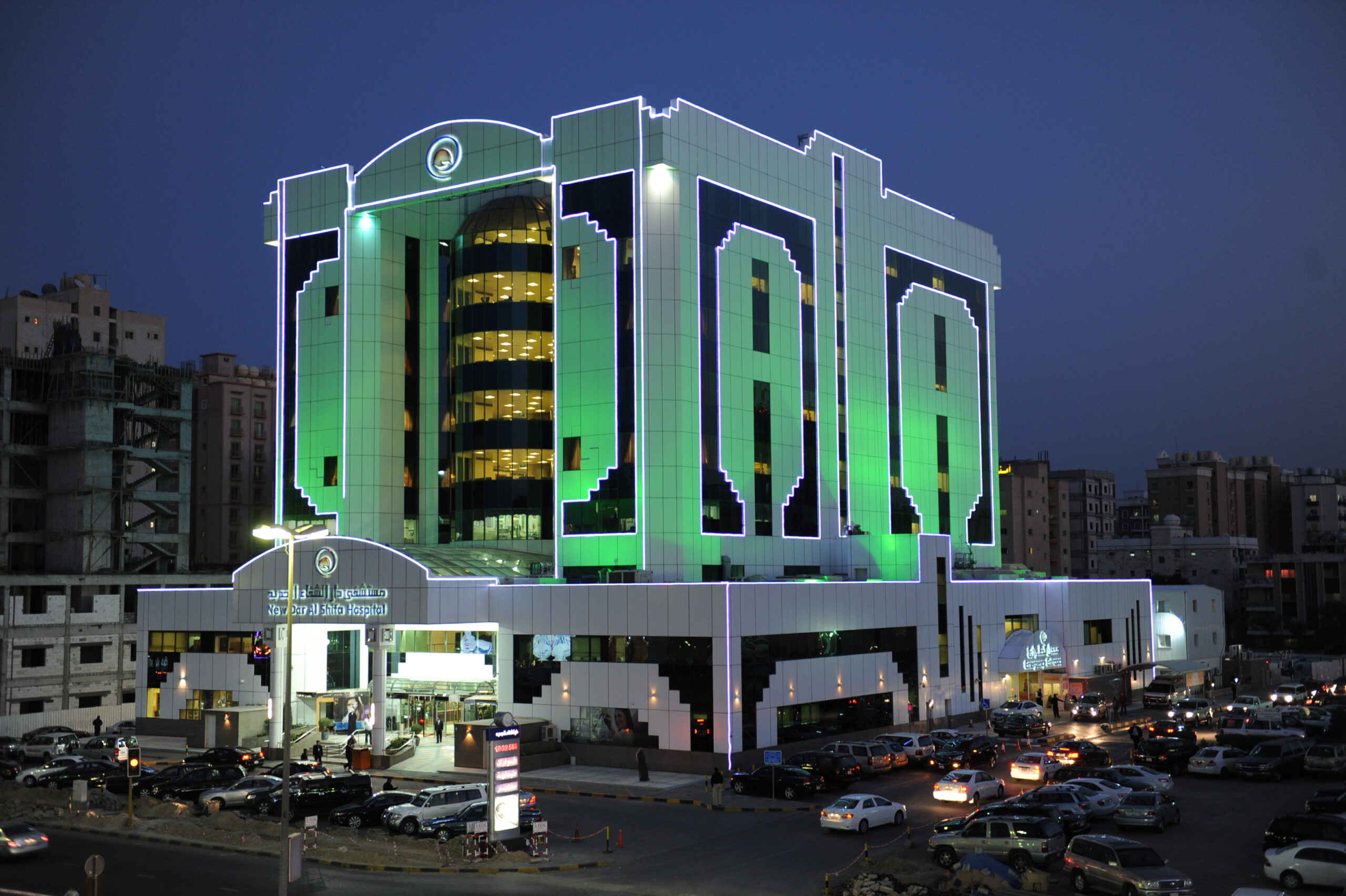
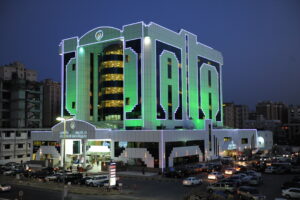
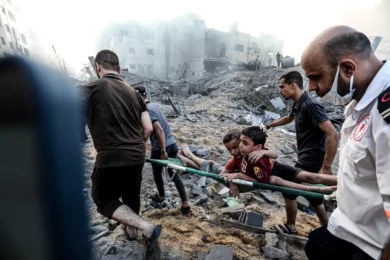
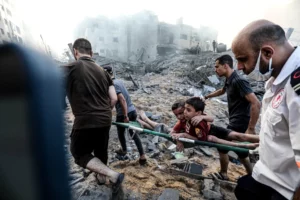 [Editors’ note: A major American liberal daily solicited from Gilbert Achcar an article about the ongoing Gaza war, but ended up rejecting his submission as “not a good fit for us.”]
[Editors’ note: A major American liberal daily solicited from Gilbert Achcar an article about the ongoing Gaza war, but ended up rejecting his submission as “not a good fit for us.”]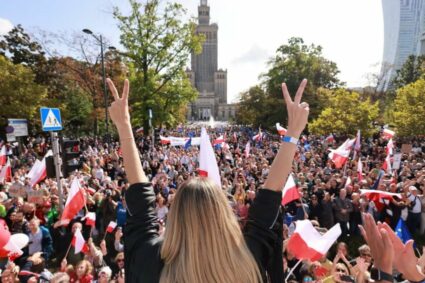
 Poland’s October 15 parliamentary elections have ended the eight-year rule of the incumbent
Poland’s October 15 parliamentary elections have ended the eight-year rule of the incumbent 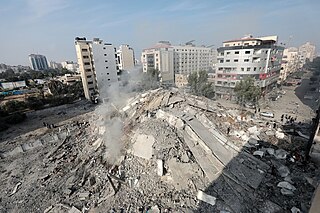
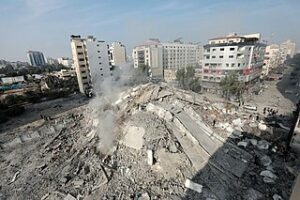 For Gilbert Achcar, specialist in the contemporary Arab world at the University of London, the West cannot escape the extension of the Israeli-Palestinian conflict on its lands. But how can we understand this quasi-global solidarity within the Muslim world? Interview.
For Gilbert Achcar, specialist in the contemporary Arab world at the University of London, the West cannot escape the extension of the Israeli-Palestinian conflict on its lands. But how can we understand this quasi-global solidarity within the Muslim world? Interview.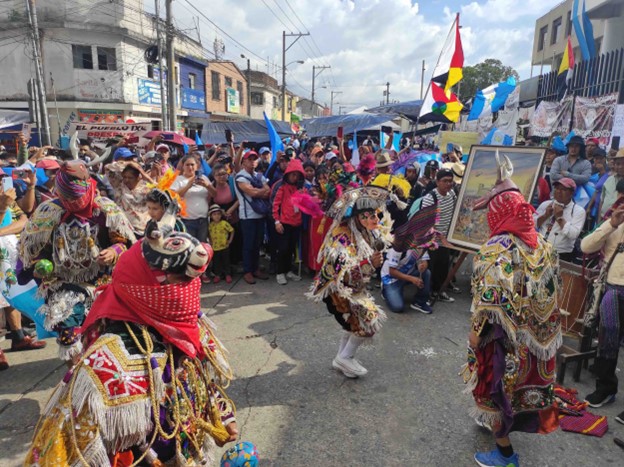
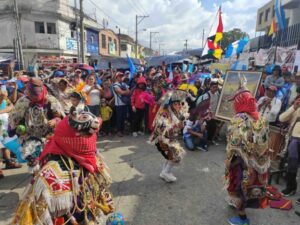
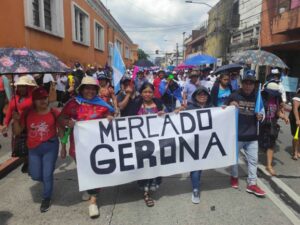
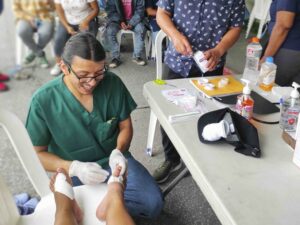
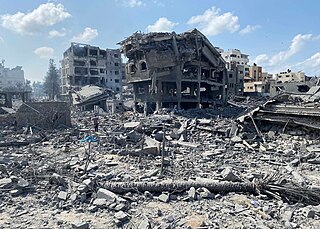
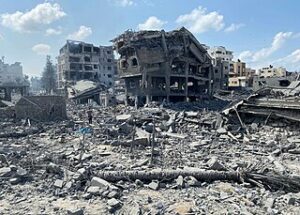
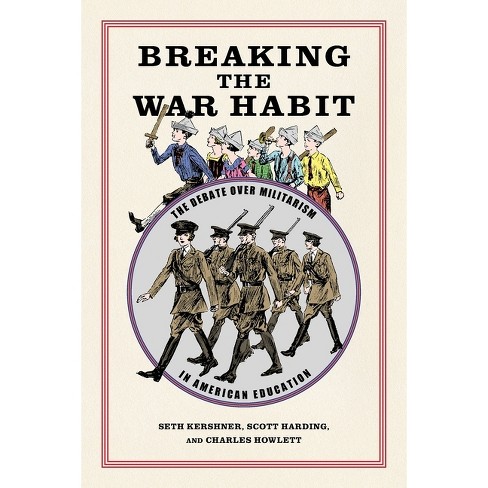
 A review of Breaking the War Habit: The Debate Over Militarism in American Education, by Seth Kershner, Scott Harding, and Charles Howlett. (University of Georgia Press, 2023).
A review of Breaking the War Habit: The Debate Over Militarism in American Education, by Seth Kershner, Scott Harding, and Charles Howlett. (University of Georgia Press, 2023).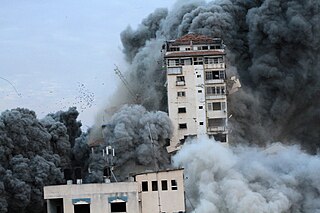
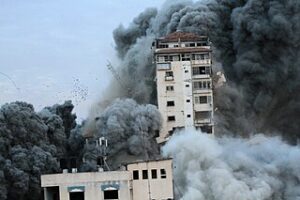 In the last few days, Gaza has epitomized the global North-South divide more than any other conflict in contemporary history. The indecent unanimity of Western governments in unreservedly expressing their unconditional support of the Israeli state—at the very moment when the latter had already and quite obviously embarked on a campaign of war crimes against the Palestinian people of unprecedented magnitude in the 75-year-long history of the regional conflict—has been truly sickening. Since the 7th of October, these governments have been outbidding each other in this endeavour—from projecting the Israeli flag on Berlin’s Brandenburg Gate, London’s Parliament, Paris’s Eiffel Tower and Washington’s White House, to sending military hardware to Israel as well as dispatching U.S. and UK naval reinforcements to the Eastern Mediterranean in a gesture of solidarity with the Zionist state, to prohibiting diverse forms of expression of political support to the Palestinian cause, thus curtailing elementary political freedoms.
In the last few days, Gaza has epitomized the global North-South divide more than any other conflict in contemporary history. The indecent unanimity of Western governments in unreservedly expressing their unconditional support of the Israeli state—at the very moment when the latter had already and quite obviously embarked on a campaign of war crimes against the Palestinian people of unprecedented magnitude in the 75-year-long history of the regional conflict—has been truly sickening. Since the 7th of October, these governments have been outbidding each other in this endeavour—from projecting the Israeli flag on Berlin’s Brandenburg Gate, London’s Parliament, Paris’s Eiffel Tower and Washington’s White House, to sending military hardware to Israel as well as dispatching U.S. and UK naval reinforcements to the Eastern Mediterranean in a gesture of solidarity with the Zionist state, to prohibiting diverse forms of expression of political support to the Palestinian cause, thus curtailing elementary political freedoms.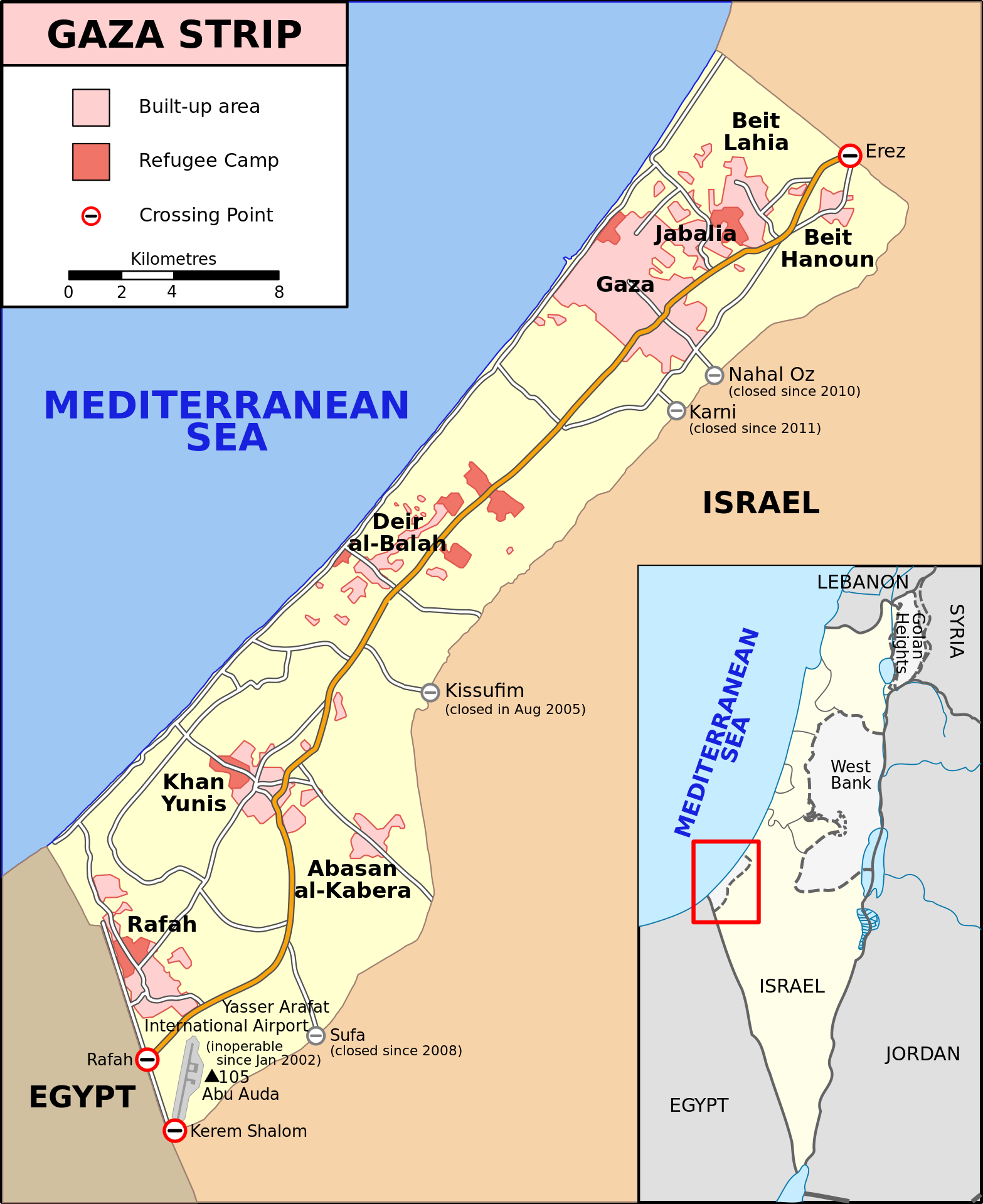
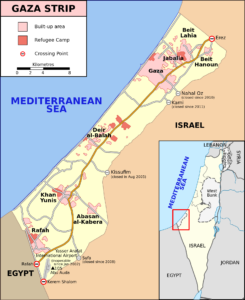 The following article was originally published by Joseph Daher, a Syrian/Swiss academic and Marxist internationalist, in the journal
The following article was originally published by Joseph Daher, a Syrian/Swiss academic and Marxist internationalist, in the journal 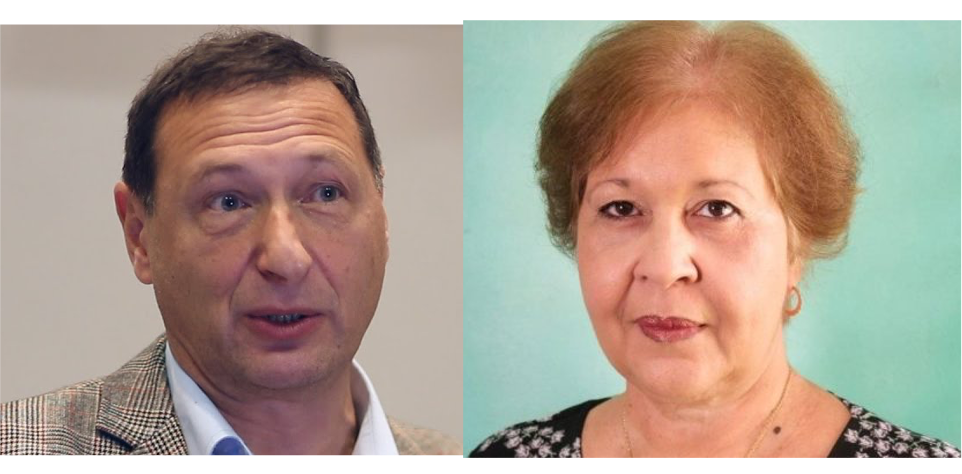
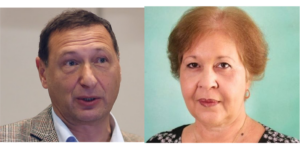
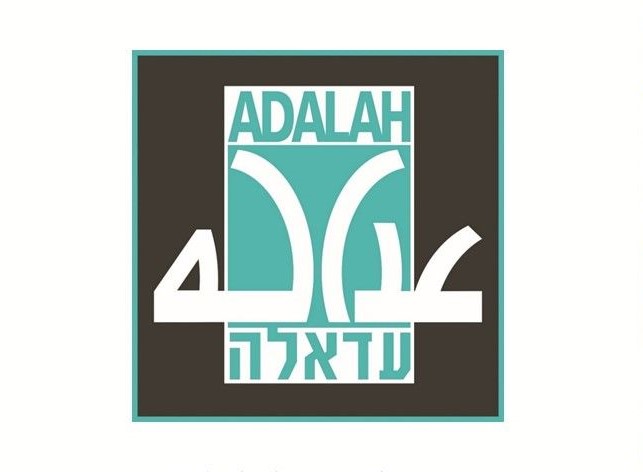
 Oct. 11, 2023
Oct. 11, 2023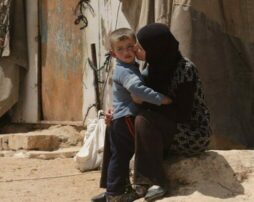
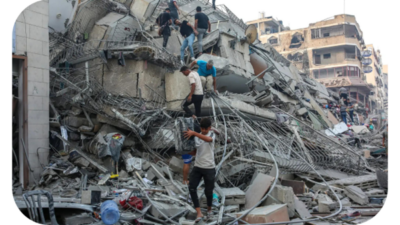
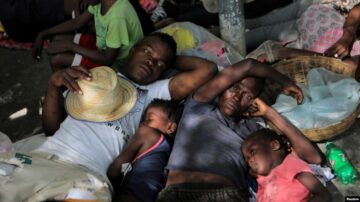
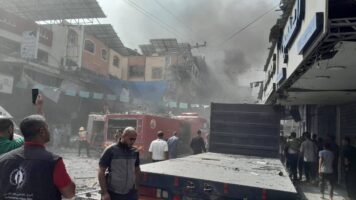
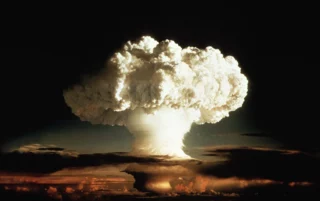
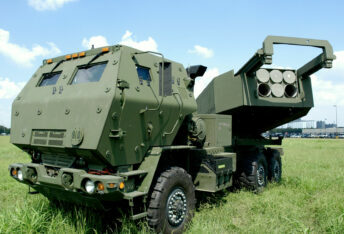
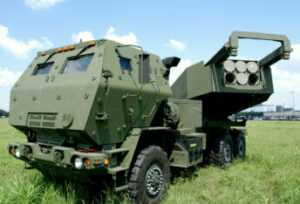 This is a reply to Gilbert Achcar, following his
This is a reply to Gilbert Achcar, following his 